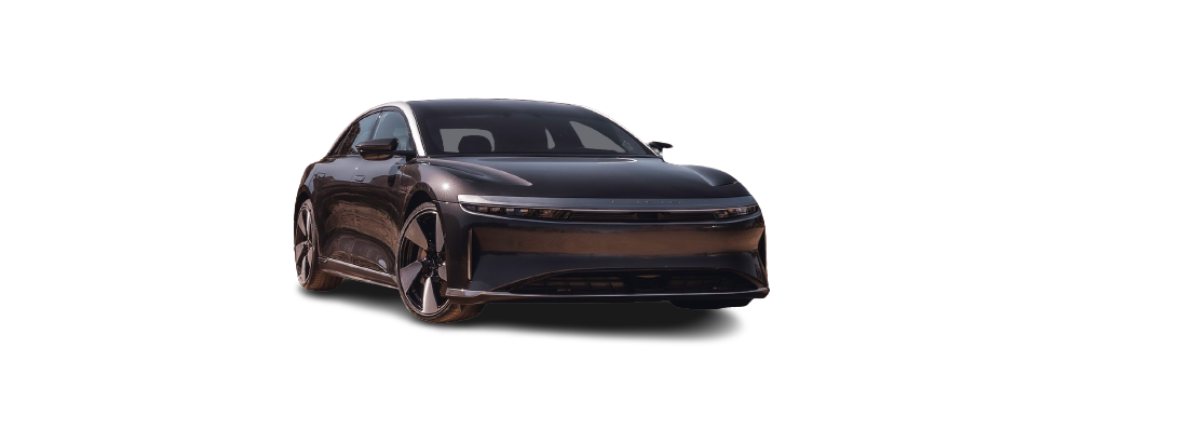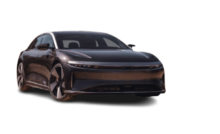2022 Lucid Air Tire Care and Maintenance Owners Manual




2022 Lucid Air Tire Care and Maintenance


Inspecting and Maintaining Tires
WARNING: The tires should be regularly checked for wear and to make sure that there are no cuts, bulges, or exposure of the ply/cord structure. Do not drive with tires that are worn, damaged, or inflated to the incorrect pressure. Driving under any of these conditions could lead to collision due to tire failure and/or loss of control and result in serious injury or death to the occupants or others.
Always consider tire conditions when driving, and regularly inspect the tread and sidewalls for any sign of distortion (bulges), cuts, or wear.
Good driving practice will improve the mileage you obtain from your tires and avoid unnecessary damage.
- Always ensure that the tire pressures are correctly adjusted.
- Always observe the posted speed limits and advisory speeds.
- Avoid pulling away quickly or hard acceleration.
- Avoid making fast turns or braking sharply.
- Avoid potholes and objects on the road.
- Do not run over curbs or hit the tire against the curb when parking.
CAUTION: Avoid contaminating tires with vehicle fluids that can cause damage.
Tire wear
WARNING: The tire wear indicators show the minimum tread depth recommended by the tire manufacturer. Tires that have worn to this point will have reduced grip and poor water displacement characteristics.
Tires fitted as original equipment have tread wear indicators molded into the tread pattern.
When the tread has been worn down to approximately 2/32 inch (1.6 mm), the indicators become flush with the surface of the tread pattern, producing the effect of a continuous band of rubber across the width of the tire.
A tire must be replaced as soon as an indicator band becomes flush to the tread, indicating the tread has reached the minimum permitted by legislation.
NOTE: Your Lucid Service Center will evaluate tire wear when servicing your vehicle.
Wheel alignment and tire balance
Unbalanced wheels (sometimes noticeable as steering wheel vibration) may affect vehicle handling and tire life. Even with regular use, wheels can get out of balance. Therefore, you should balance your wheels as required.
NOTE: If tire wear is uneven (on one side of the tire only) or becomes abnormally excessive, you should check the wheel alignment.
Wheel and tire rotation
WARNING: Your vehicle may be fitted with different size tires on the front and rear wheels. The front and rear wheels may also have different offsets. Do not move wheels between the front and rear axles as this will severely affect vehicle handling
Lucid does not recommend moving the wheels between the front and rear axles, or from side to side on the same axle pair.
Punctured tires
WARNING: Do not drive the vehicle with a punctured tire. Even if the punctured tire has not deflated, it is unsafe to use as the tire may deflate suddenly at any time.
Your vehicle is fitted with tubeless tires, which may not leak when penetrated, provided the object remains in the tire.
If, however, you feel a sudden vibration or ride disturbance while driving, or you suspect your tire or vehicle has been damaged, immediately reduce your speed. Drive slowly while avoiding heavy braking or sharp steering, and when safe to do so, stop the vehicle.
Inspect the tires for damage. If a tire is under-inflated and does not appear to have any damage to the sidewall, try to repair it using the tire repair kit. See Tire Repair Kit. If you cannot detect the cause or the tire is too heavily damaged, have the vehicle recovered to a tire repair center, or a Lucid Service Center to have the vehicle inspected.
A puncture will eventually cause the tire to lose pressure, which is why frequent checking of tire pressures is important. Punctured or damaged tires must be permanently repaired or replaced as sOon as possible.
Age degradation
Tires degrade over time due to the effects of ultraviolet light, extreme temperatures, high loads, and environmental conditions. It is recommended that tires are replaced every six years, but may require replacement more frequently.
Maintaining Tire Pressures
WARNING: Use a gauge to check tire pressures when COLD. Under-inflation is the most common cause of tire failures and may result in severe tire cracking, tread separation, or “blowout,” with an unexpected loss of vehicle control and increased risk of injury.
Each tire should be checked monthly and inflated to the pressure recommended on the vehicle placard or tire inflation pressure label. (If your vehicle has tires of a different size than the size indicated on the vehicle placard or tire inflation pressure label, you should determine the proper tire inflation pressure for those tires).
Driving on a significantly under-inflated tire causes the tire to overheat and can lead to tire failure. Under-inflation also reduces battery range and tire tread life, and may affect the vehicle’s handling and stopping ability.
As an added safety feature, your vehicle has been equipped with a Tire Pressure Monitoring System (TPMS) that illuminates a low tire pressure indicator when one or more of your tires is significantly under-inflated. When the low tire pressure indicator illuminates, you should stop and check your tires as soon as possible, and inflate them to the proper pressure. See Tire Pressure Monitoring System (IPMS).
WARNING: TPMS is not a substitute for proper tire maintenance. As the driver, it is your responsibility to maintain correct tire pressure, even if under-inflation has not reached the level to trigger illumination of the TPMS low tire pressure indicator.
Checking tire pressure
CAUTION: Perform pressure checks when the tires are COLD. A hot tire at or below recommended cold inflation pressure is dangerously under-inflated.
CAUTION: If the vehicle has been parked in strong sunlight or used in high ambient temperatures, do not reduce the tire pressures. Move the vehicle into the shade and allow the tires to cool before checking
WARNING: Do not exceed the maximum pressure stated on the sidewall of the tire. Over inflation could cause the tire to fail suddenly.
NOTE: The COLD Tire pressure is defined as the air pressure in a tire that has been standing in excess of three hours, or driven for less than one mile.
To view current tire pressures on the Pilot Panel. Select
NOTE: Tire pressure is shown once the vehicle is driven over 13 miles per hour.
If it is necessary to check the tires when they are warm, you should expect the pressures to have increased. Do not reduce the pressure of warm tires in an attempt to match the recommended cold tire pressures.
To view the recommended COLD tire pressures for your vehicle, select the RECOMMENDED tab. Always inflate your tires to the pressures recommended by Lucid, even if it is different from the maximum inflation pressure information found on the tire itself.
Adjusting tire pressure
The recommended COLD tire pressures are also shown on the Tire and Loading Information Label located on the driver’s side door jamb.
Recommended Tire Inflaton Pressure depends on the type of tires mounted on the vehicle at the factory. The label, Iocated on the left door jamb between front and rear doors, provides the Tire and Loading Information for your vehicle.
To check and adjust tire pressures:
- Remove the cap from the valve, then firmly press the tire gauge onto the valve and measure the pressure.
- If required, add air to reach the required pressure.
- Check the pressure by removing the tire gauge and then re-attaching it. Failure to remove and re-attach the gauge to the valve could cause the gauge to show an incorrect reading.
- If the tire pressure is too high, remove the gauge and release air from the tire by pressing on the metal stem in the center of the valve. Refit the gauge to the valve and check the pressure.
- Repeat the process of adding or removing air as required until the correct tire pressure is reached.
- Refit the valve cap.
Tire valves
Keep the valve caps screwed down firmly to prevent water or dirt from entering the valve. Check the valves for leaks when checking the tire pressures.
Flat spots
If the vehicle is stationary for a long period when the ambient temperature is high, the tires may form flat spots. When the vehicle is driven, these flat spots will cause a vibration that will steadily disappear as the tires warm up and regain their original shape.
Tire pressures during long-term storage
Inflate tires to the maximum pressure as indicated on the tire wall to minimize flat spots during storage.
WARNING: The tire pressures must be reduced to the correct pressure before the vehicle is driven.
Replacing Tires and Wheels
WARNING: For your safety, it is recommended that only wheels and tires that match the original specification are used on the vehicle. Specifications for approved winter tires are available by contacting your Lucid Service Center.
WARNING: Operation of the Tire Pressure Monitoring System (TPMS) may be affected if the tires are replaced with a different specification from the originals.
Wheel rims and tires are matched to suit the handling characteristics of the vehicle. Always check that replacement tires comply with the original specification. If tires other than those specified are used, ensure that the load and speed ratings (shown on the tire sidewall) equal or exceed those of the original specification.
For the specification of the original wheels and tires installed on the vehicle, refer to Wheel and Tire Specifications.
Ideally, tires should be replaced as sets of four. If this is not possible, replace the tires in pairs (front and rear). When tires are replaced, the wheels should always be re-balanced and alignment checked.
Asymmetric tires
WARNING: Vehicle traction and handling will be seriously impaired if the tires are incorrectly installed on the wheels. Your vehicle is equipped with Asymmetric tires that have different tread patterns on the outer and inner edge of the tire. On the outside edge, the tread pattern exhibits large tread blocks that are designed to provide dry traction and handling thanks to a larger contact area with the road.
On the inside edge, the tread block is smaller to provide a better-wet grip. An increased number of grooves helps disperse water on wet roads and reduce the risk of aquaplaning. This means the tire is built to provide great performance in both wet and dry conditions.
Asymmetric tires must be mounted on the wheel with the correct sidewall facing outwards from the vehicle. The sidewall of the tire is marked with the word OUTSIDE.
When new tires are installed, always make sure the tires are correctly oriented.
Run-flat tires
CAUTION: The installation of run-flat tires is not recommended by Lucid as they may cause issues with the sensors for the Tire Pressure Monitoring System (TPMS).
Seasonal Tire Types
Summer tires
Your vehicle may be originally equipped with high-performance summer tires. Summer tires are designed for maximum dry and wet road performance but are not designed to perform well in winter conditions.
Lucid recommends using winter tires if driving in cold temperatures or on roads where snow or ice may be present.
WARNING: Summer tires are not designed to provide adequate traction during cold temperatures, on snow, or ice. Selecting and installing the appropriate tires for winter conditions is important to ensure the safety and optimum performance of your vehicle.
All-season tires
Your vehicle may be originally equipped with all-season tires. These tires are designed to provide adequate traction in most conditions year-round, but may not provide the same level of traction as winter tires in snowy or icy conditions. All-season tires can be identified by ALL SEASON and/or M+S (mud and snow) on the tire sidewall.
Winter tires
WARNING: Always follow the tire manufacturer’s instructions. Pay special attention to the maximum speed you can drive your vehicle and the correct tire pressures.
WARNING: The traction provided by winter tires on dry roads may be less than your original specification tires.
Use winter tires to increase traction when driving in sustained temperatures below 50°F (10°C), or in snowy or icy conditions.
For winter tires, always install a complete set of four tires at the same time. All winter tires should be the same diameter, brand, construction, and tread pattern on all four wheels.
For recommendations on winter tires, contact your Lucid Service Center.
Driving in Low Temperatures
Tire performance is reduced in low ambient temperatures, resulting in reduced grip and increased susceptibility to damage from impacts. Performance tires can temporarily harden when cold, causing you to hear rotational noise for the first few miles (kilometers) until the tires warm up.
Tire Traction Devices
Tire chains
CAUTION: The use of tire chains is not approved or recommended by Lucid. Using tire chains may damage your vehicle’s suspension, body, wheels, and/or brake lines. Damage caused by using tire chains will not be covered by the New Vehicle Limited Warranty.
Tire socks
When the tires do not provide sufficient traction, tire socks may be fitted and used at speeds of up to 25 mph (40 kph) in snowy conditions.
NOTE: Winter tires usually offer more traction than tire socks.
NOTE: Although approved by Lucid, the use of tire socks may still be prohibited according to location. Check the local laws before installing tire socks.
For recommendations on tire socks, contact your Lucid Service Center.
Recent Posts
VW Jetta Engine Fuse Box Diagram
Access the comprehensive 2010-2018 VW Jetta Passenger Fuse Box Diagram to troubleshoot electrical issues effectively.…
VW Jetta Passenger Fuse Box Diagram
Explore the comprehensive VW Jetta Passenger Fuse Box Diagram to troubleshoot electrical issues effectively. Understand…
2023 Ford F-150 Lightning Fuse Box Diagram
Under Hood Fuse Box Location Remove the front luggage compartment cover. Under Hood Fuse Box…
2022 Kawasaki NINJA H2 SX SE Brake Lever Adjuster Owner’s Manual
2022 Kawasaki NINJA H2 SX SE Brake Lever Adjuster Owner's Manual NOTICE Only adjust the front…
2023 Land Rover Range Rover Evoque Exiting The Vehicle Owners Manual
2023 Land Rover Range Rover Evoque Exiting The Vehicle SINGLE LOCKING WARNING Before exiting the…
2023 Land Rover Range Rover Evoque Front Seats Owners Manual
2023 Land Rover Range Rover Evoque Front Seats FRONT SEAT SAFETY Make sure to read…
